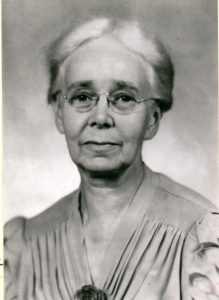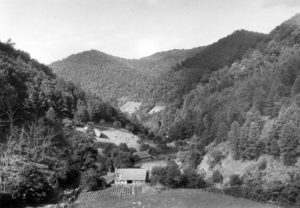Pioneers are people who create paths through unknown places. Lucy Braun did so, figuratively and literally.
Emma Lucy Braun was born on April 19, 1889, in Cincinnati, Ohio, which would be her home for her entire life (she died at age 81 in 1971). She roamed the local woodlands as a young girl with her family. Her parents quizzed her and her sister, Annette, on the names of the plants and animals they encountered, sparking an intense interest in natural history. In high school, she began pressing and drying plants, building a reference collection that eventually contained 11,891 specimens (now held by the Smithsonian Institution). She first studied geology at the University of Cincinnati, earning BS and MS degrees. She then turned to botany, earning her PhD degrees there in 1914, the second woman to receive a doctorate from the university. The first was her sister Annette, who beat Lucy by two years, with a doctorate specializing in the study of moths.

After finishing her degrees, she began working as a teacher and researcher for the University of Cincinnati, advancing stepwise to full professor in 1946. She retired from the university two years later, determined to escape the demands of teaching so she could concentrate on her research. In fact, her pre-eminent work, the book Deciduous Forests of Eastern North America, was published two years after retirement, in 1950.
She was a pioneer in the understanding of hardwood forest ecology. And she did it the hard way, by hiking through the forests she sought to understand. She walked an estimated 65,000 miles through the forests of the southern Appalachians, at a time when women seldom performed such extensive or demanding field work. And by her side for most of those miles walked her sister Annette. Braun continued exploring throughout her life, leading hikes until she was 80 years old.
That work made her the singular expert on the plant ecology of the eastern deciduous forest. With her background in geology, she was able to relate plant communities to site conditions, and supplementing her own field work with survey records from earlier times, she was able to reconstruct the changes in forest composition over hundreds of years. Her book on deciduous forests and her other work, published in more than 180 papers, remain among the seminal foundations of modern forest ecology.

She was also a pioneer for the role of women in ecology and conservation. She advised mostly female graduate students. In 1917, she founded the Wildflower Preservation Society of North America (now known as the Cincinnati Wildflower Preservation Society), which recently celebrated its centenary. She was the first woman elected president of the Ohio Academy of Science (1933-1934) and the first woman president of the Ecological Society of America, elected in 1950 (the society established the E. Lucy Braun Award for outstanding student poster presentations in 1987). Just before her death in 1971, she was the first woman inducted into the Ohio Conservation Hall of Fame.
As well as being a pioneering scientist and role model for women, Braun was a staunch conservationist. She fought for the protection of intact forest ecosystems for their biodiversity and scientific values. The Nature Conservancy’s first property in Ohio is named for her—the E. Lucy Braun-Lynx Prairie Preserve. It is part of an 18,000-acre tract that comprises the Edge of Appalachia Preserve. Braun loved this area, which her research showed was particularly high in biodiversity in mixtures of open prairies and woodlands. Braun was responsible for several other land conservation projects throughout the midwest.
At a speech to the Kentucky Garden Club in 1935, Braun explained her passion for preserving the forest:
“Nowhere in the whole world is there the equal in beauty and magnificence of our eastern deciduous forest. It is unexcelled. And in Kentucky and Tennessee this deciduous forest reached its superlative development….Why not save a piece of your native country, your native state, in its original condition as a monument to the original beauty and grandeur of your forests, just as you save an historical shrine?”
Just as the pioneers worked their ways westward through the eastern deciduous forest, using the wood and clearing the land for farms, pastures and towns, so Lucy Braun pioneered the work of keeping some of that land around for people like her—men and women—to learn, perhaps, how to keep the broader environment intact as well.
References:
Pine Mountain Settlement School Collections. Emma Lucy Braun. Available at: https://pinemountainsettlement.net/?page_id=15577. Accessed April 18, 2018.
Rafferty, John P. 2018. Emma Lucy Braun, American Botanist and Ecologist. Encyclopedia Britannica, 4-12-2018. Available at: https://www.britannica.com/biography/Emma-Lucy-Braun. Accessed April 18, 2018.
The Nature Conservancy. Edge of Appalachia Preserve, The E. Lucy Braun Lynx Prairie Preserve. Available at: https://www.nature.org/ourinitiatives/regions/northamerica/unitedstates/ohio/placesweprotect/tnc-eoa-buzzardroost-rock-trail-map-and-guide-1.pdf. Accessed April 18, 2018.
